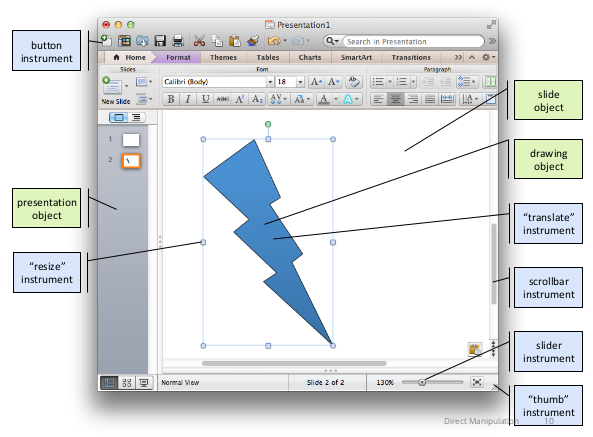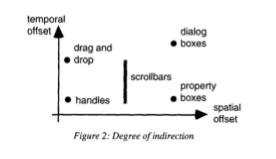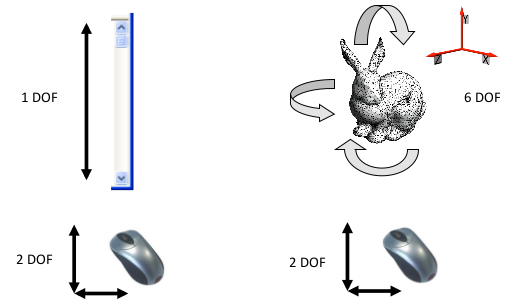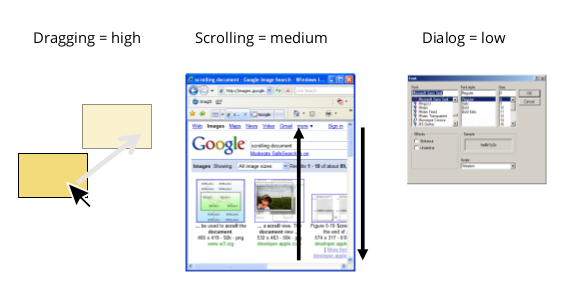Direct Manipulation
- When the virtual representation of an object is manipulated in a similar way to a real-world object
- Proposed in 1983 by Ben Schneiderman
- Can be traced back to Sketchpad (Ivan Sutherland)
Principles
- Continous representation of task objects and actions
- Objects are manipulated by physical actions, not comple syntax
- Fast, incremental, and reversible actions with effects on task objects immediately apparent
- Layer, self-revealing approach to learning
Benefits
- User feel as if they are interacting with the domain rather than the interface
- User can focus on task rather than the technology
Why it's not always used
- Many commands are invoked indirectly
- Menus, dialog boxes, toolbars
- Many objects of interest are hidden
- Text styles, page layout
- many objects in the interface are not objects of interest
- Toolbar palettes
Look and Feel
Look - how manipulatable objects are presented in the interface
Feel - how user expression is translated into commands to manipulate objects
Interaction Model
- By Lafon, 2000
- A set of principles, rules and properties that guide the design of an interface
- Describes how to combine interaction techniques that defines the look and feel
- Can be used to evaluate specific interaction designs
Instrumental Interaction
- A model of interaction based on how we naturally use tools to manipulate objects in the real world
Interaction instrument - a necessary mediator between the user and domain objects
Domain objects - he thing of interest, data and associated attributes, which is manipulated using an interaction instrument

Instrument activation - when instrument is under user's control
- WIMP instruments activated spatially and temporally
Refication and Meta-Instruments
Reification - turning concepts into something concrete
- An instrument is the reification of a command; scrollbar => reifies scroll commands
Meta-instrument - an instrumnet that acts on another instrument
- The other instrument becomes an object of interest
- e.g. pencil is an instrument to manipulate the object "paper"; when the pencil breaks, it becomes an object of interest to be manipulated by the sharpener meta-instrument
Object Reification - turning attributes of a primary object into other objects of interest
Evaluating Instrument
Degree of indirection - spatial/temporal offset between instrument and action on object
- 2D measure of spatial and temporal offsets of instrument
- Spatial dimension
- e.g. _near: _drag to translate, handles on to resize
- e.g. med: scrollbars
- e.g. far: dialog boxes
- Temporal dimension
- e.g. short: direct dragging response
- e.g. med: activate tool in toolbar, the start direct manipulation
- e.g. long: using dialog, finishing drag-and-drop

Degree of integration - ratio of degrees of freedom of instrument to degrees of freedom of input device

Degree of Compatibility - the similarity between the physical actions on the instrument and the response of the object

Direct Manipulation and Instrumental Interaction
- Direct manipulation interface allows a user to directly act on a set of objects in the interface
Direct means instruments are visually indistinguishable from objects they control
- Actions on instrument/object entities are analogous to actions on similar objects in real world
- Actions on instrument/object entities preserve the conceptual linkage between instrument and object
Should build on existing experiences and intuitions to aid learning
- e.g. trash bin in OS and the real world
Direct Manipulation Issues
- Visually impared users can't see graphics
- Consumes valuable screen space
- Switching between keyboard and pointer is time consuming
- Analogies may not be clear
- Users need to learn meaning of visual representations, which may be misleading